45 reading fat on nutrition labels
How to Read Food Labels Without Being Tricked - Healthline 19.08.2020 · Reading labels can be tricky. Consumers are more health-conscious than ever, so some food manufacturers use misleading tricks to convince people to buy highly processed and unhealthy products. Daily Value on the New Nutrition and Supplement Facts Labels Feb 25, 2022 · The Nutrition Facts label must list total fat, saturated fat, trans fat, cholesterol, sodium, total carbohydrate, dietary fiber, total sugars, added sugars, protein, and certain vitamins and ...
How to read food labels | healthdirect For example, a product that is 'low fat' may have more kilojoules than another similar product. Check the Nutrition Information Panel to see how the product compares. How to read the Nutrition Information Panel. The Nutrition Information Panel tells you the size of a standard serving of the product and which nutrients are contained in that serving.

Reading fat on nutrition labels
PDF TO CARE 4 YOURSELF READING A NUTRITION FACTS LABEL - novoMEDLINK Potassium300mg 9% Protein 6g Total Carbohydrate18g Saturated Fat 0g Dietary Fiber 6g Vitamin A 0% Calcium 4% Folic Acid 0% Sugars 1g Trans Fat 0g Polyunsaturated Fat 0.5g Monounsaturated Fat 0.5g Vitamin C 0% Start here What you eat is important. But so is how much you eat. So start by looking here. How To Read Food and Beverage Labels - National Institute on Aging Most older adults exceed the recommended limits for saturated fats, sodium, and added sugars. Compare and choose foods to get less than 100% DV of these each day, making sure to adjust for how many calories are in your diet. Additionally, many older adults do not get the recommended amounts of dietary fiber, vitamin D, calcium, and potassium. Food Labels | CDC - Centers for Disease Control and Prevention If you eat the whole thing, you are eating 8 times the amount of calories, carbs, fat, etc., shown on the label. Total Carbohydrate shows you types of carbs in the food, including sugar and fiber. Choose foods with more fiber, vitamins, and minerals. Choose foods with lower calories, saturated fat, sodium, and added sugars.
Reading fat on nutrition labels. How to Use the Nutrition Fact Label, Eat Right, NHLBI, NIH When using the Nutrition Facts label as a guide, try these tips: Keep these low: saturated fats, trans fats, cholesterol, and sodium. Get enough of these: potassium, fiber, vitamins A and C, calcium, and iron. Use the Percent Daily Value (% DV) column when possible; 5% DV or less is low, 20% DV or more is high. Visit the Smart Food Shopping ... Learn How the Nutrition Facts Label Can Help You Improve Your Health Read the Nutrition Facts labels on your packaged food and drinks to keep track of sugars, fats, protein, and other nutrients. Most sodium we consume is from salt, and salt is commonly in processed foods. Read labels and choose the product with less sodium. Drink plain water instead of sugary beverages. Interpreting Total Fat and Types of Fat on Food Labels - Nina Cherie ... Now, at the end of the day, since all high-fat foods tend to drive up calorie counts, it's typically recommended that you limit your intake of total fat to 25-35% of your daily calories. Of this amount, saturated fats and trans fats should comprise less than 7-10% and no more than 1%, respectively. PDF A Guide to Reading Food Labels - University of Rochester Another important part of the label is the number of calories from fat. You should limit the number of calories from fat to 20-35% of your total daily calories. In the sample label, there are 250 calories in one serving and 110 calories from fat. This means almost 50% of the calories in a single serving of this food come from fat.
Nutrition labels required by end 2023 for freshly prepared drinks … Aug 11, 2022 · SINGAPORE: Food and beverage outlets will by end of 2023 be required to include nutrition labels on their menus indicating drinks that contain higher levels of sugar and saturated fat. These ... Fat Content on Food Labels - Reading Between the Lines The Mayo Foundation continued, "Still, you may be able to tell if a product contains trans fat, even if it's not directly listed on the food label. Look for the words ' hydrogenated ' or 'partially hydrogenated' in the list of ingredients. These terms indicate that the product contains trans fat. How to Read Nutrition Facts Labels the Right Way - GoodRx However, foods that contain less than 0.5 g per serving are allowed to list the trans fats as 0 g on a nutrition label, so consumption of these fats is still possible. Foods that may contain small amounts of trans fats include: Packaged baked goods Ready-to-eat frozen meals Refrigerated doughs Fried foods Margarine Shortening PDF Reading Nutrition Labels - Xavier University Fat is important for our diet (the brain is 60% fat!), but not all fats are created equal. Experts agree we should limit saturated fats and avoid trans fats. More nutritious sources of fat include olive oil, avocado, fatty fish, and nuts. Fat also contributes to making food more satisfying.
Key Points when Reading Nutrition Labels | Mayo Clinic Connect We want to aim for less than 5 grams of saturated fat per serving, and 0 grams of trans fat. Sodium. We often encourage no more than 600 mg sodium per meal, or less than 200-300 mg sodium per serving. Carbohydrate. Consider looking at Total Carbohydrate first and foremost. The rest of the breakdown can inform you of nutritional value ... Understanding Food Nutrition Labels | American Heart Association When the Nutrition Facts label says a food contains "0 g" of trans fat, but includes "partially hydrogenated oil" in the ingredient list, it means the food contains some trans fat, but less than 0.5 grams per serving. So, if you eat more than one serving, you could end up eating too much trans fat. The Basics of the Nutrition Facts Label - Academy of Nutrition and ... Step 4: Check Out the Nutrition Terms. Low calorie: 40 calories or less per serving. Low cholesterol: 20 milligrams or less and 2 grams or less of saturated fat per serving. Reduced: At least 25% less of the specified nutrient or calories than the usual product. Good source of: Provides at least 10 to 19% of the Daily Value of a particular ... How To Read Nutrition Labels - Mayo Clinic Diet 3. Check the % Daily Value The % Daily Value (DV) tells you how much a nutrient in a serving of food contributes to a daily diet. 2,000 calories a day is used for general nutrition advice. Low is 5% or less. Aim for low in saturated fat, trans fat, cholesterol, sodium, and added sugars. High is 20% or more.
Reading and Understanding Food Labels and Nutrition Info | Beaumont Health A good range is between 20-60 grams; the lower number representing a 10-percent fat diet and the higher number a 30-percent fat diet. When considering the amount of fat you eat, don't forget to count meat, which doesn't have a label. A three-ounce serving of lean meat, fish or poultry can contain anywhere from three to 10 grams of fat.
Understanding Ingredients on Food Labels | American Heart … 06.03.2017 · Food labels are an important source of information about calories and the nutritional value of the foods you eat, a crucial tool in building a heart-healthy diet. Food labels are an important source of information about calories and the nutritional value of the. Skip to main content . Alert Community Emergency Resources. Find Resources ×. Heart Attack and Stroke …
How to Read Nutrition Labels | Eat Smarter USA Some specific things I like to look out for on my nutrition label are saturated fat, trans fat, sodium, and added sugars. While healthy natural fats are needed in our daily diet, saturated and trans fats are single-bonded fats which are not good for the body, and can result in issues such as blocked arteries and high cholesterol.
Food Labels: Fat & Cholesterol | Home & Garden Information Center total fat—20 to 35% of calories, depending on age and gender (65 grams for the 2,000-calorie intake level used in the Daily Value)* saturated fat—less than 10% of calories** trans fat— keep as low as possible cholesterol—there is no longer a specific recommended limit for dietary cholesterol, but should be consumed as little as possible
Understanding Food Labels | The Nutrition Source | Harvard T.H. These graphics promote a perception of healthfulness, which can be misleading if consumers rely only on these images without reading the Nutrition Facts panel for complete information. The FDA does not closely monitor these FOP graphics. Because research has shown that “positive” FOP labels like health stamps or checkmarks can overrate a food’s healthfulness, public …
How To Read a Nutrition Label for Bariatric Surgery & Weight Loss The sneaky thing is that if a label has less than 0.5 g of trans fats it can be labeled as zero! When reading your ingredients avoid foods that contain hydrogenated oil or partially hydrogenated oil. Saturated fat should also be limited as this can also increase your risk for heart disease and elevated cholesterol.
How to Read Nutrition Labels | Cooking Light The footnote now reads, "The % Daily Value (DV) tells you how much a nutrient in a serving of food contributes to a daily diet. 2,000 calories a day is used for general nutrition advice.". By utilizing the Percent Daily Value feature, you can see if a source can be considered a good, bad, or even excellent source of particular nutrients ...
This Is How to Read a Nutrition Facts Label on the Keto Diet To go a little deeper, each of the three macronutrients (protein, carbohydrates, and fat) contains a certain amount of calories per gram, no matter what food they're in. For instance [ * ]: 1 gram of protein = 4 calories (4 units of energy) 1 gram of carbohydrate = 4 calories (4 units of energy) 1 gram of fat = 9 calories (9 units of energy)
How to Read Everything on the Nutrition Facts Label - Food Network Take that 1600 and multiply it by 0.30 (based on our goal of getting 30% of our calories from fat). You'll get 480 calories. Then, to figure out the grams of fat you want to aim for each day,...
Reading Food Labels | ADA - American Diabetes Association Reading Food Labels | ADA Understanding Food Labels It's time to decode those food claims. Trying to figure out nutritional information on labels and packaging isn't easy. The good news is that we can help. Untangle packaging claims. If you get tripped up on food content claims, you're not alone. Fat free vs. low fat vs. reduced fat.
Quick Tips for Reading the Nutrition Facts Label - Food and Drug ... 1. Use a pair of scissors to cut along the dotted lines. 2. Fold along the center line. 3. Keep the Tip Card in your wallet or purse. Calories230 Amount per serving Serving size 2/3 cup (55g) 8...
How to Read Nutrition Labels: Fat Content, Carbs & What To Look For Nutrition labels are required to include total fat, saturated fat, and trans fat. The total amount of fat in the diet is a percentage of your calorie needs. The recommendation for the typical American diet is around 30%. For someone taking in 2,000 calories, this would mean around 70 grams of total fat per day.
How to Understand and Use the Nutrition Facts Label | FDA Nutrients to get less of: Saturated Fat, Sodium, and Added Sugars. Saturated fat, sodium, and added sugars are nutrients listed on the label that may be associated with adverse health effects - and...
Nutrition Facts: How to Read Nutrition Labels - bodyandsoulau Here are some to look for: Calorie-free: Less than 5 calories per serving. Low calorie: 40 calories or less per serving. Reduced calorie/fat: At least 25 percent less calories/fat than the ...
How to Read Food Labels for Fats and Oils Reading the ingredient lists on products will reveal the source of the fat. For oils and fats ingredient lists, fats and oils are referred to by their common names (e.g., "beef fat," "cottonseed oil"). Like other ingredient lists, the types of fat and oils used should be listed by predominance.
Food Labels | CDC - Centers for Disease Control and Prevention If you eat the whole thing, you are eating 8 times the amount of calories, carbs, fat, etc., shown on the label. Total Carbohydrate shows you types of carbs in the food, including sugar and fiber. Choose foods with more fiber, vitamins, and minerals. Choose foods with lower calories, saturated fat, sodium, and added sugars.
How To Read Food and Beverage Labels - National Institute on Aging Most older adults exceed the recommended limits for saturated fats, sodium, and added sugars. Compare and choose foods to get less than 100% DV of these each day, making sure to adjust for how many calories are in your diet. Additionally, many older adults do not get the recommended amounts of dietary fiber, vitamin D, calcium, and potassium.
PDF TO CARE 4 YOURSELF READING A NUTRITION FACTS LABEL - novoMEDLINK Potassium300mg 9% Protein 6g Total Carbohydrate18g Saturated Fat 0g Dietary Fiber 6g Vitamin A 0% Calcium 4% Folic Acid 0% Sugars 1g Trans Fat 0g Polyunsaturated Fat 0.5g Monounsaturated Fat 0.5g Vitamin C 0% Start here What you eat is important. But so is how much you eat. So start by looking here.
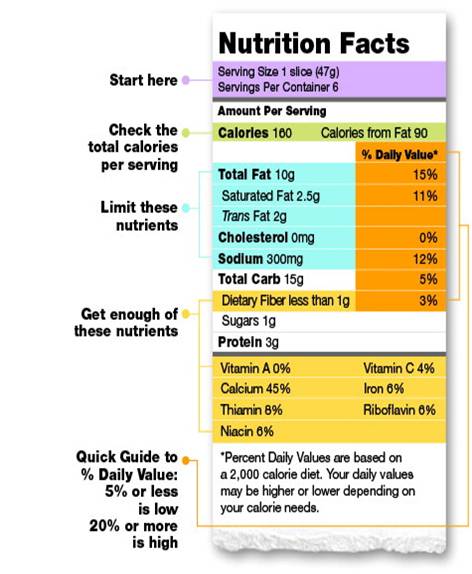
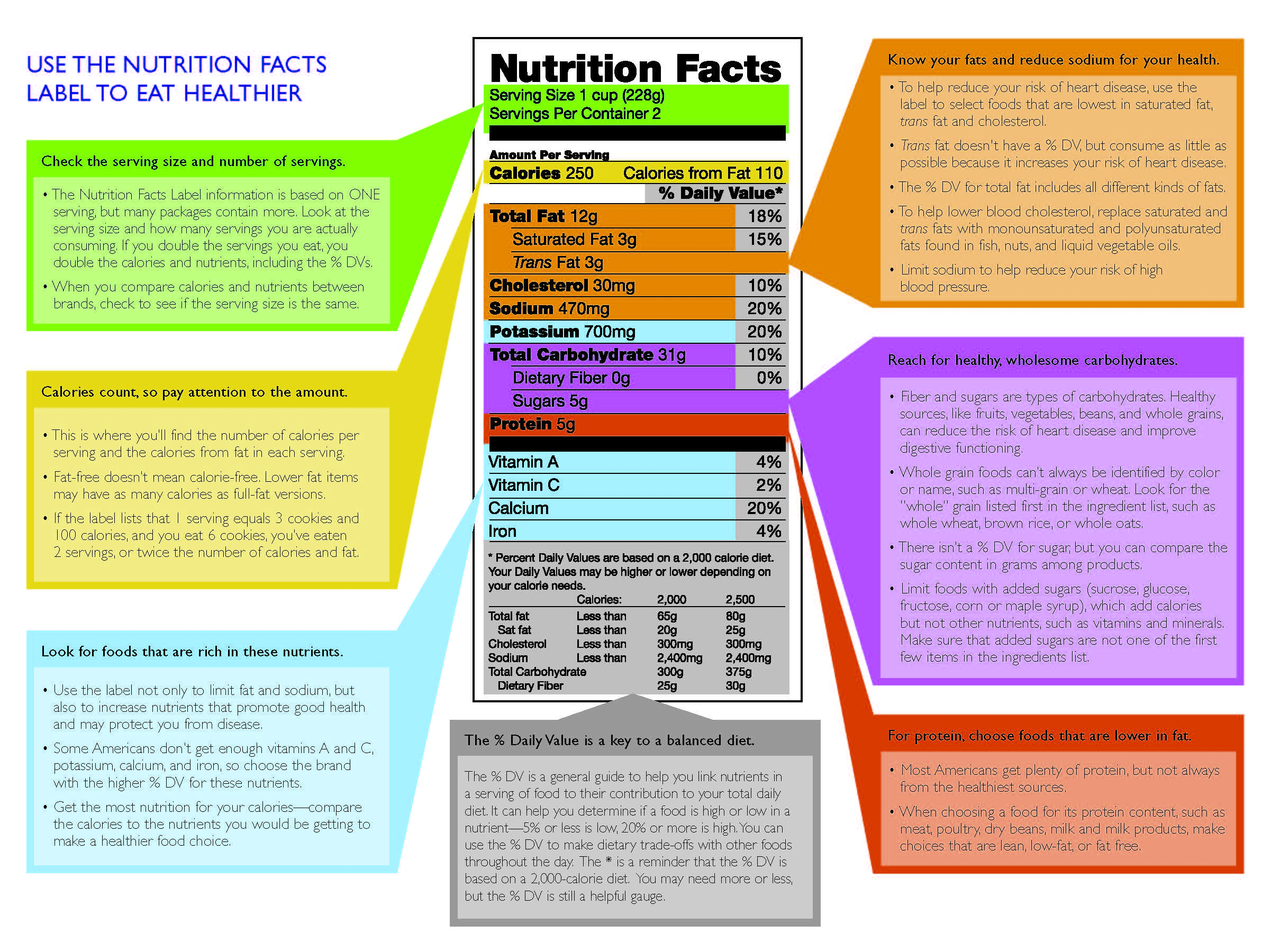
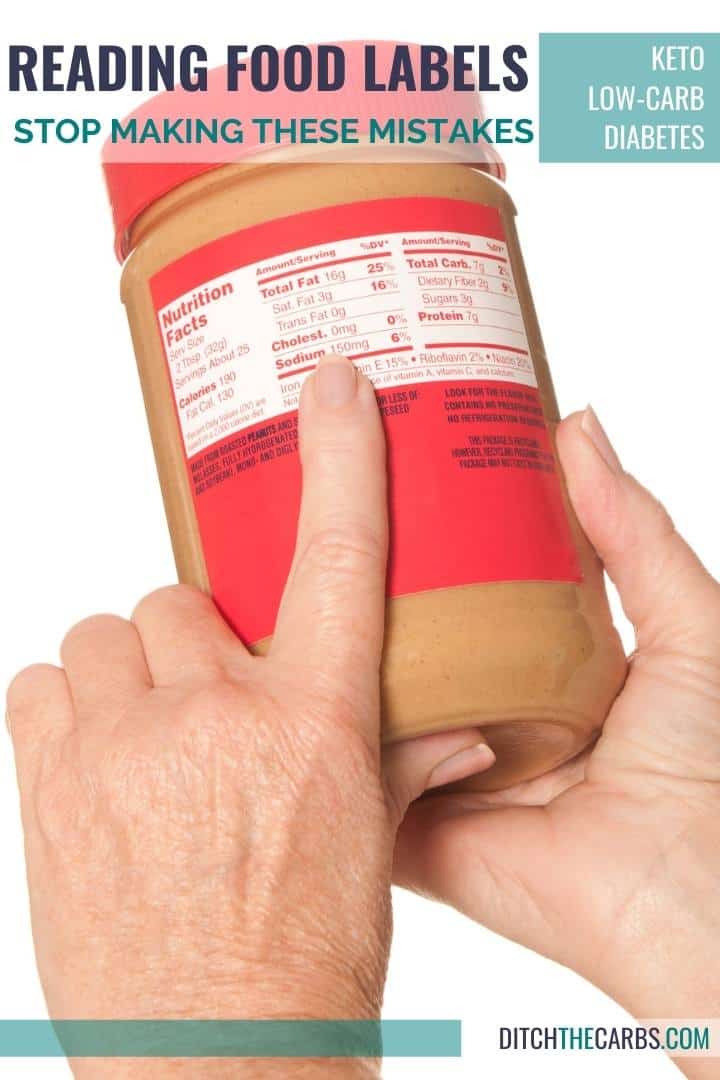

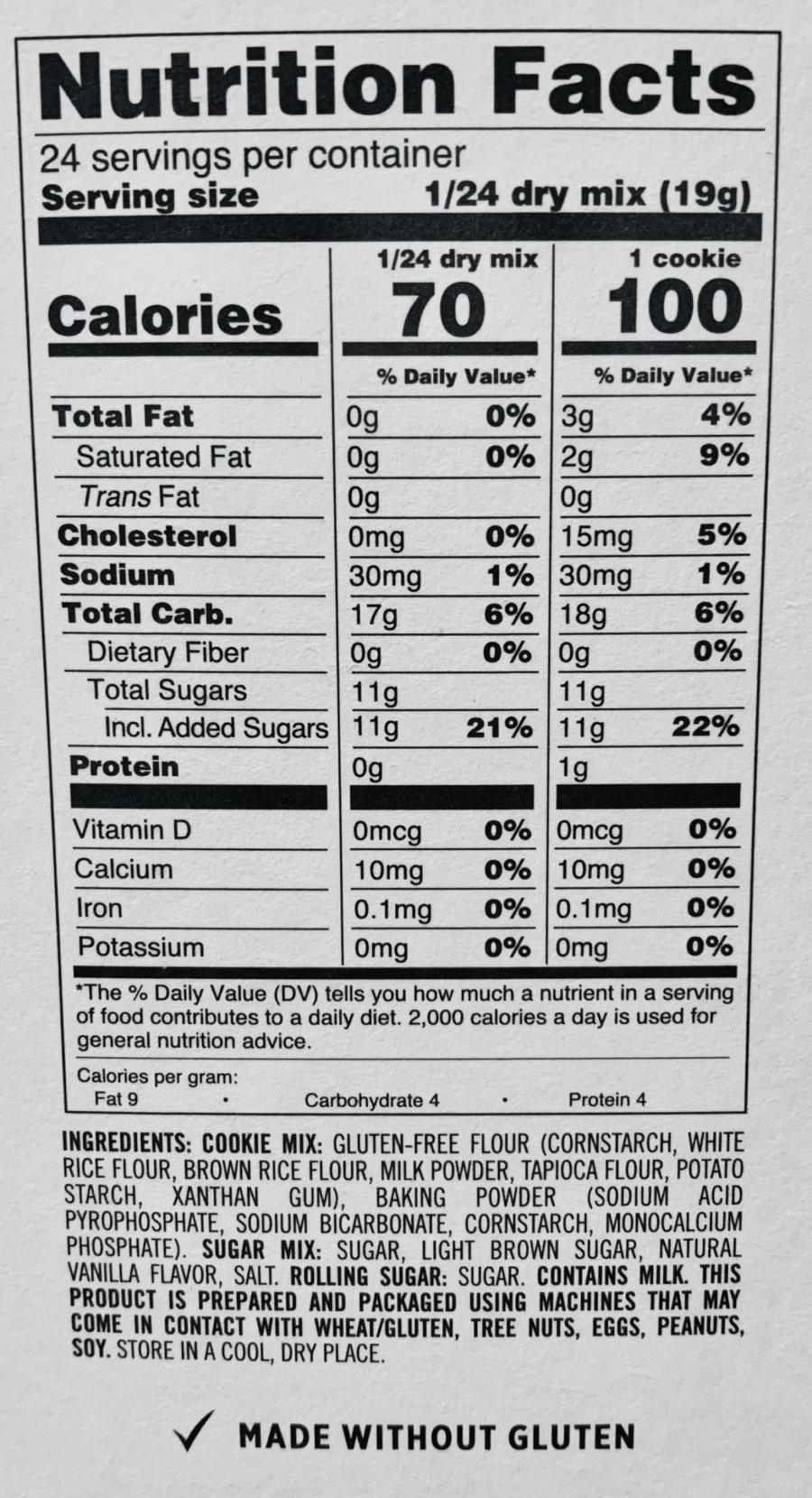
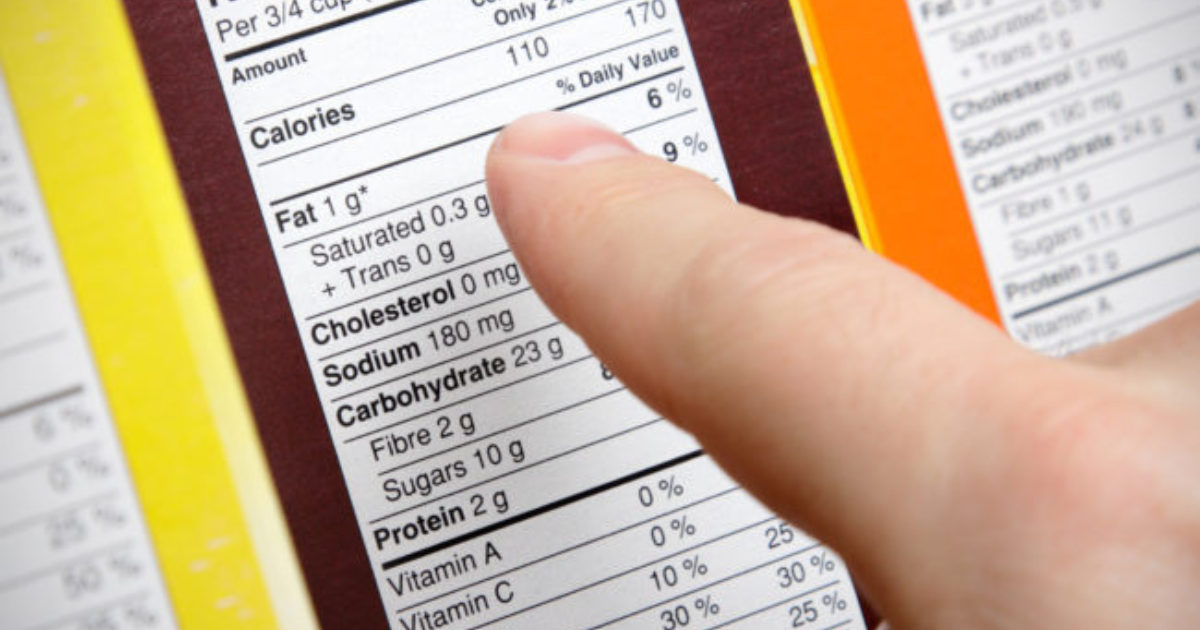
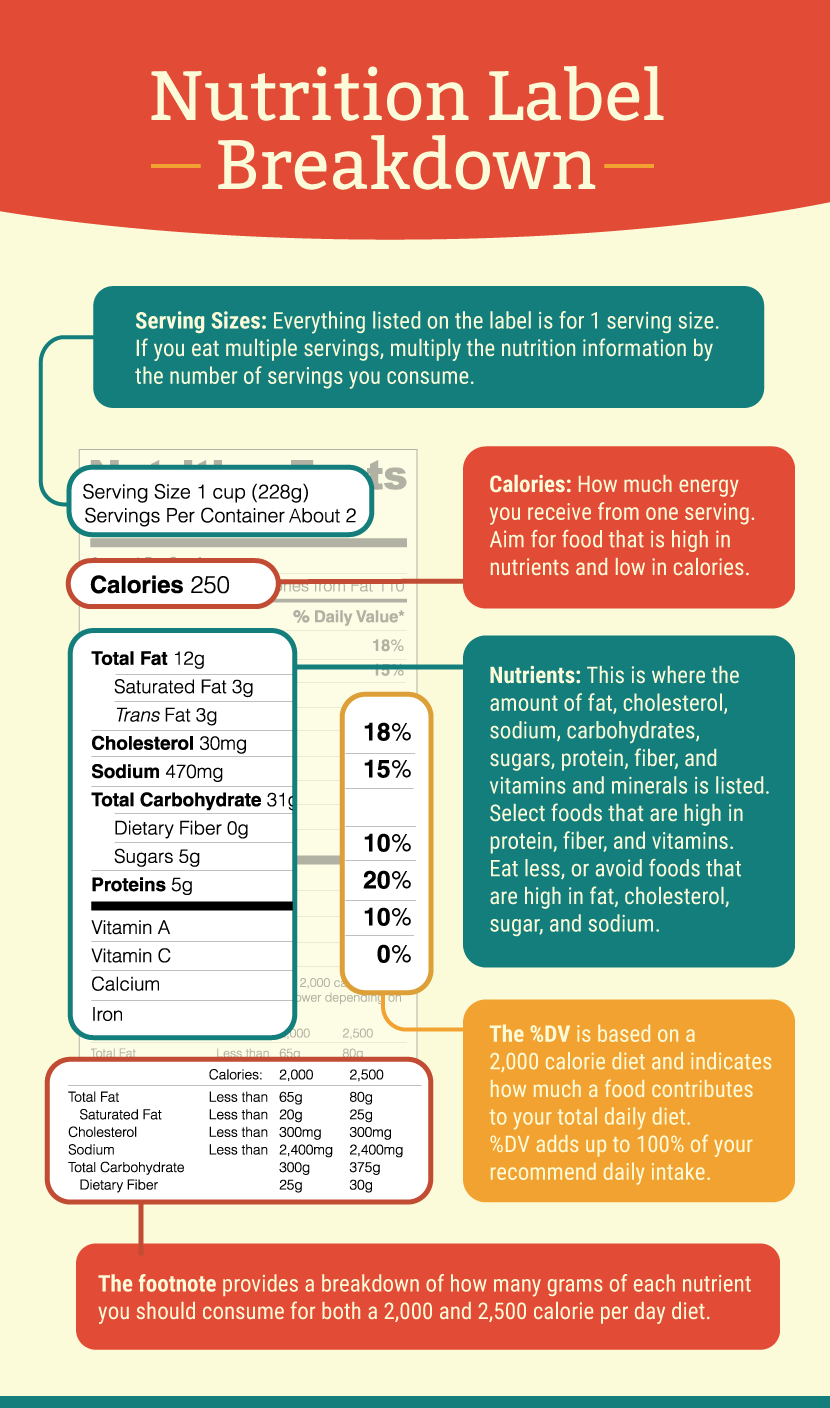
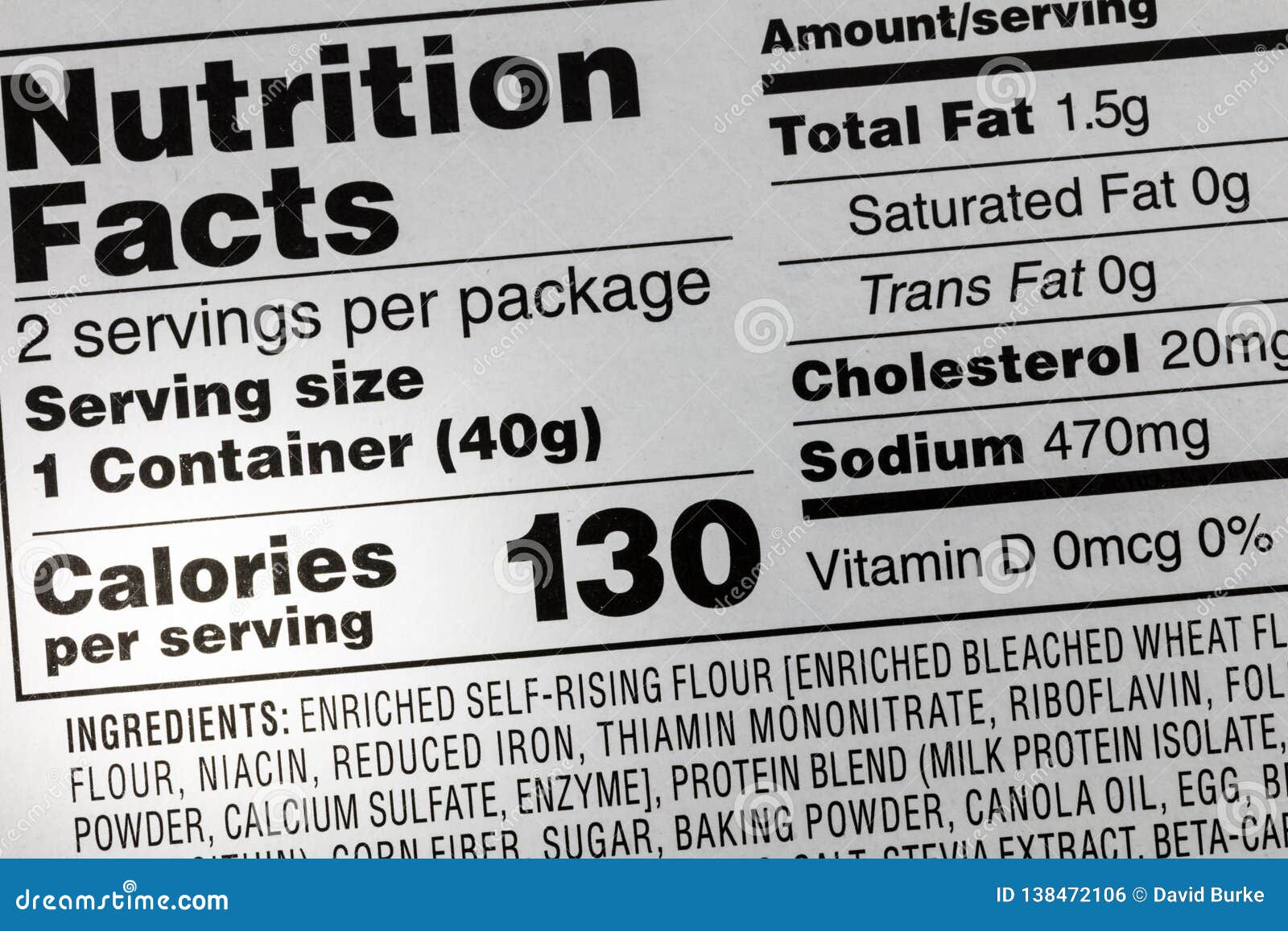
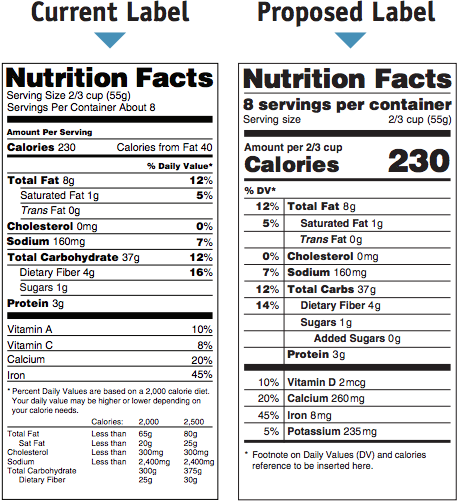






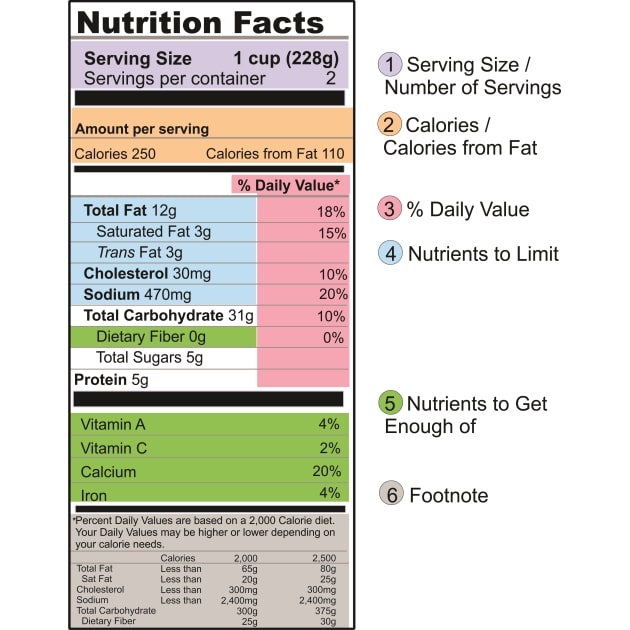


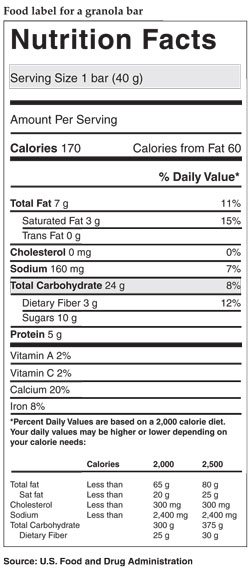

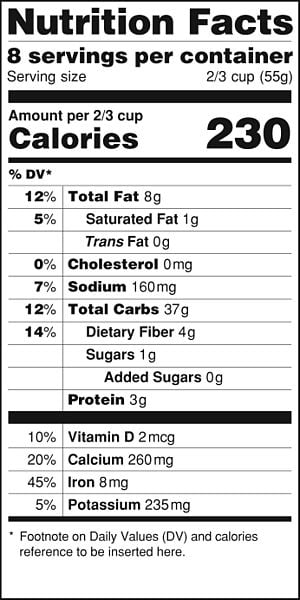
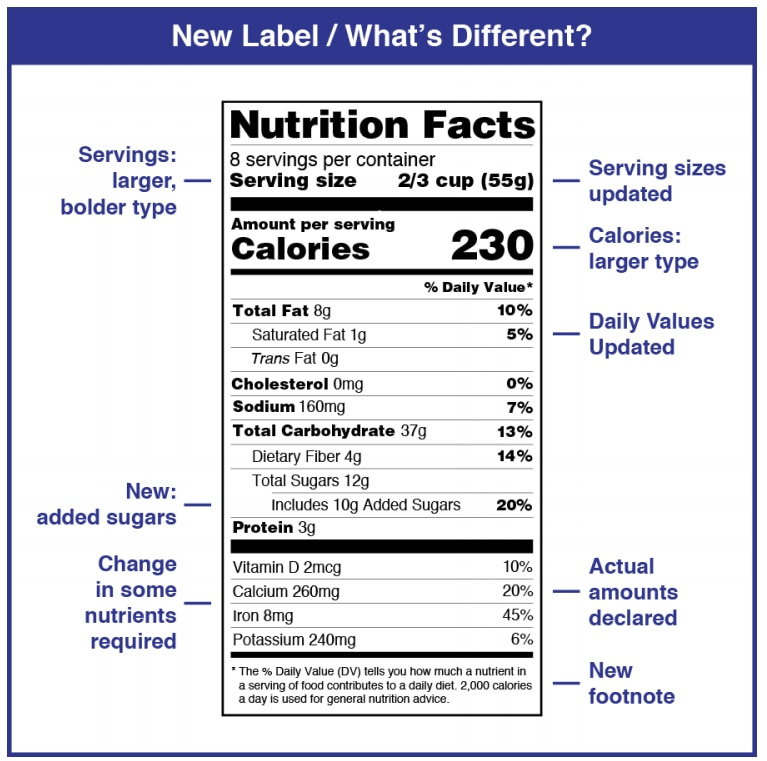
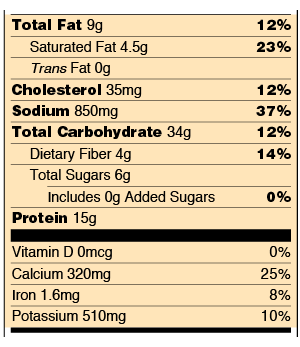

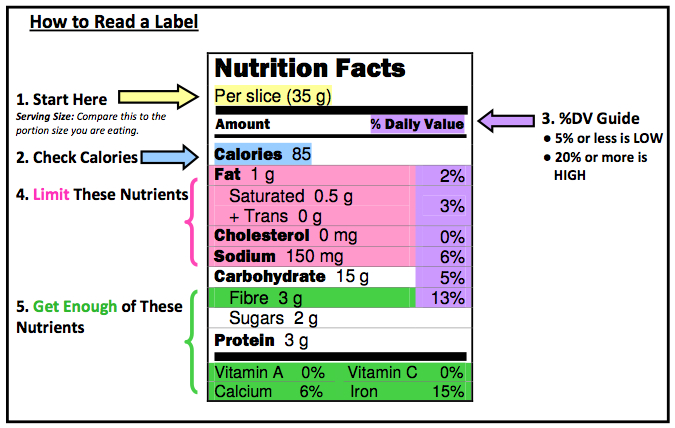




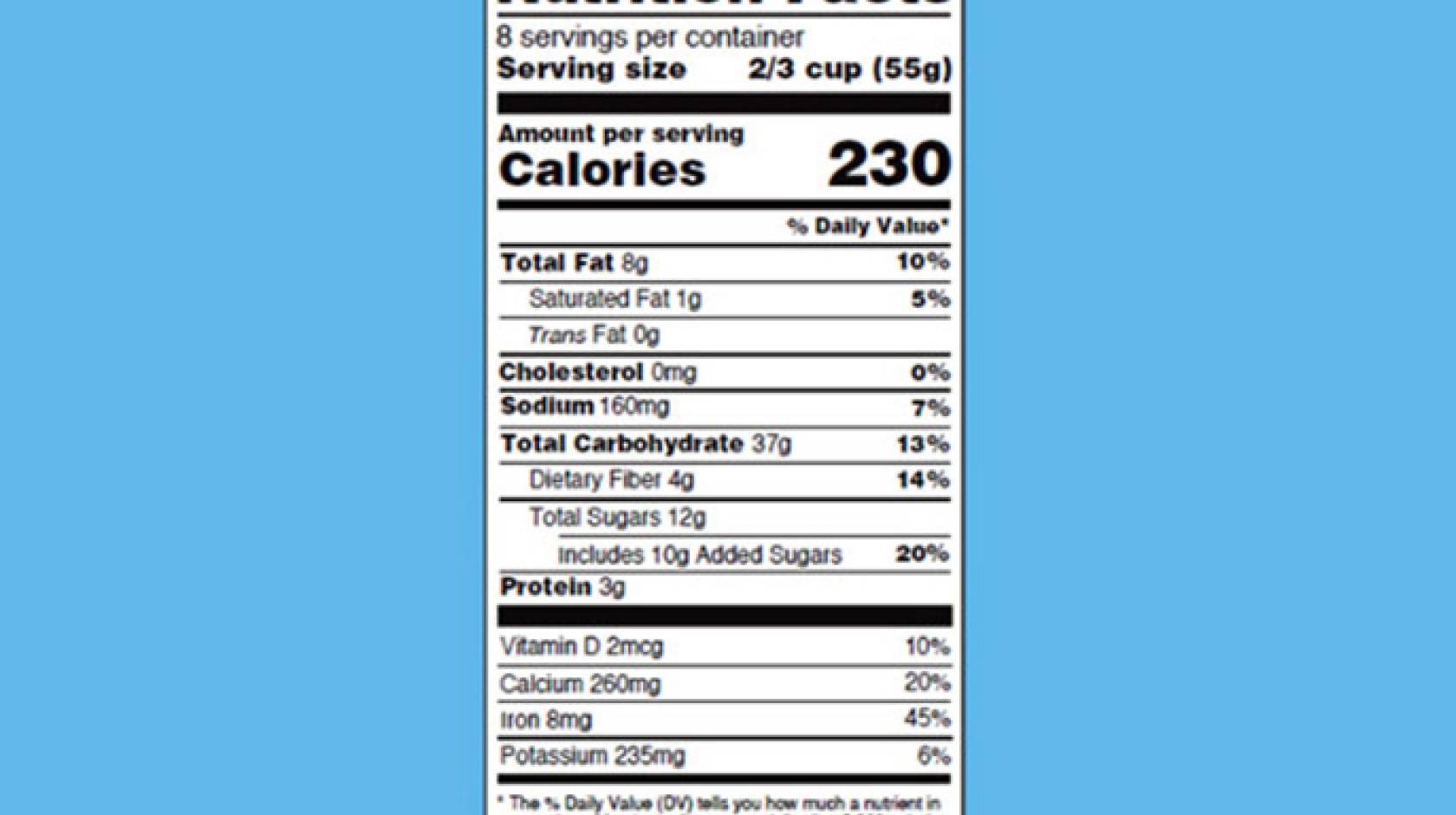
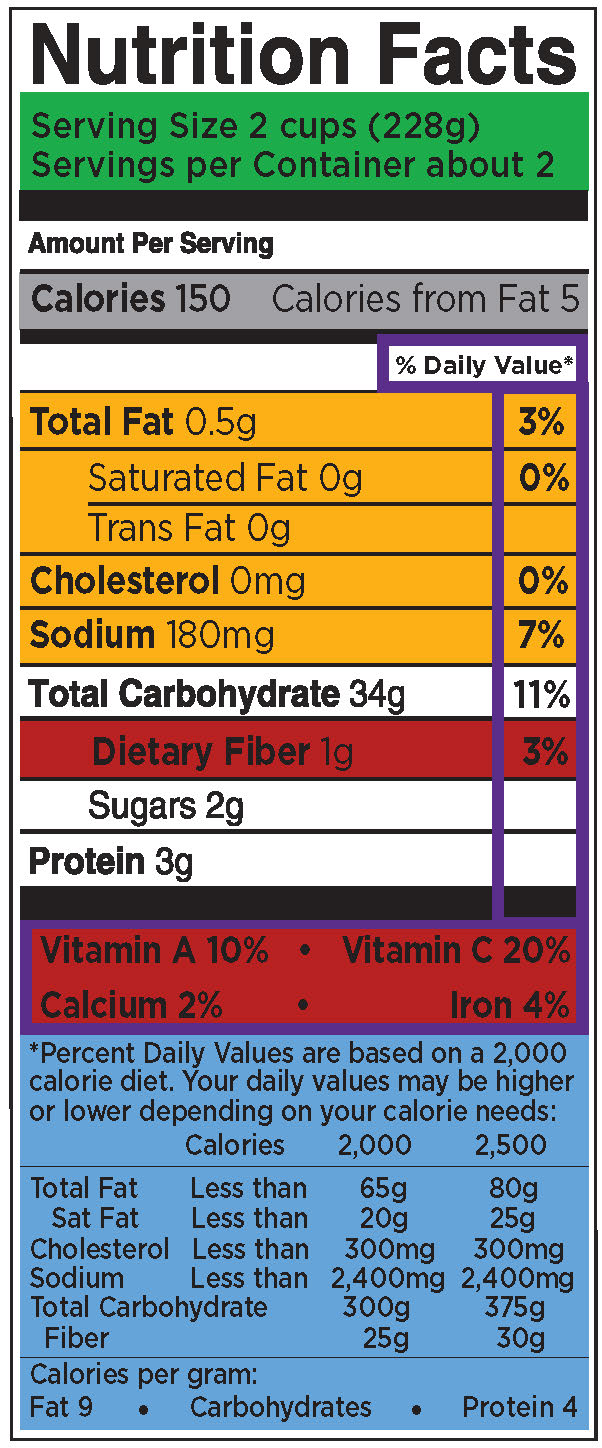



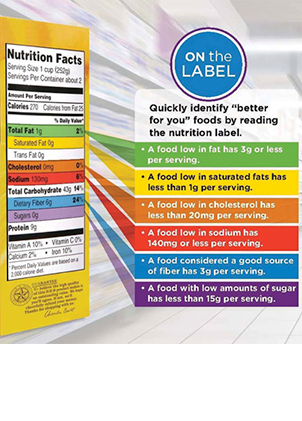





Post a Comment for "45 reading fat on nutrition labels"